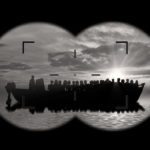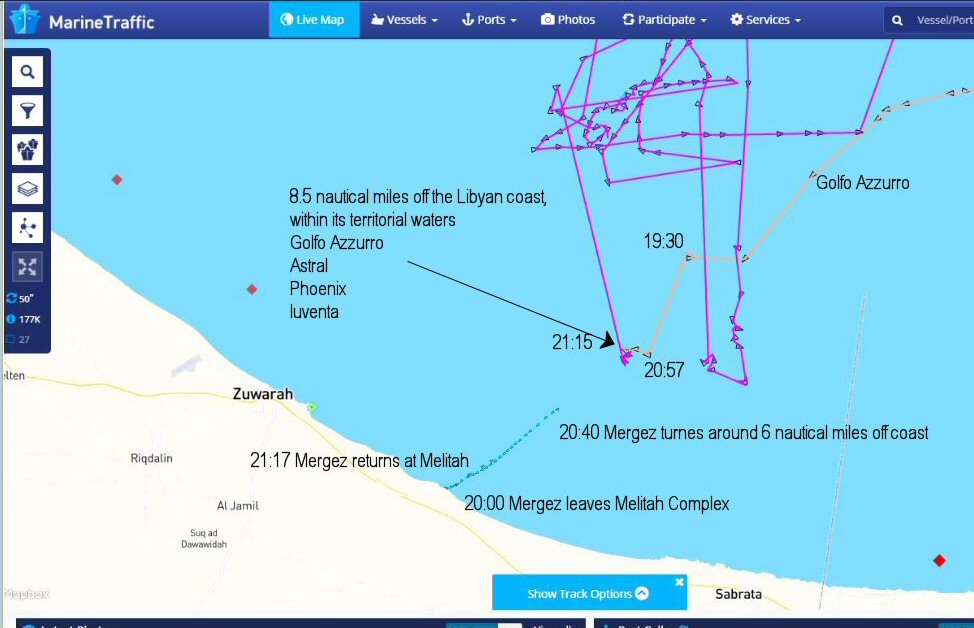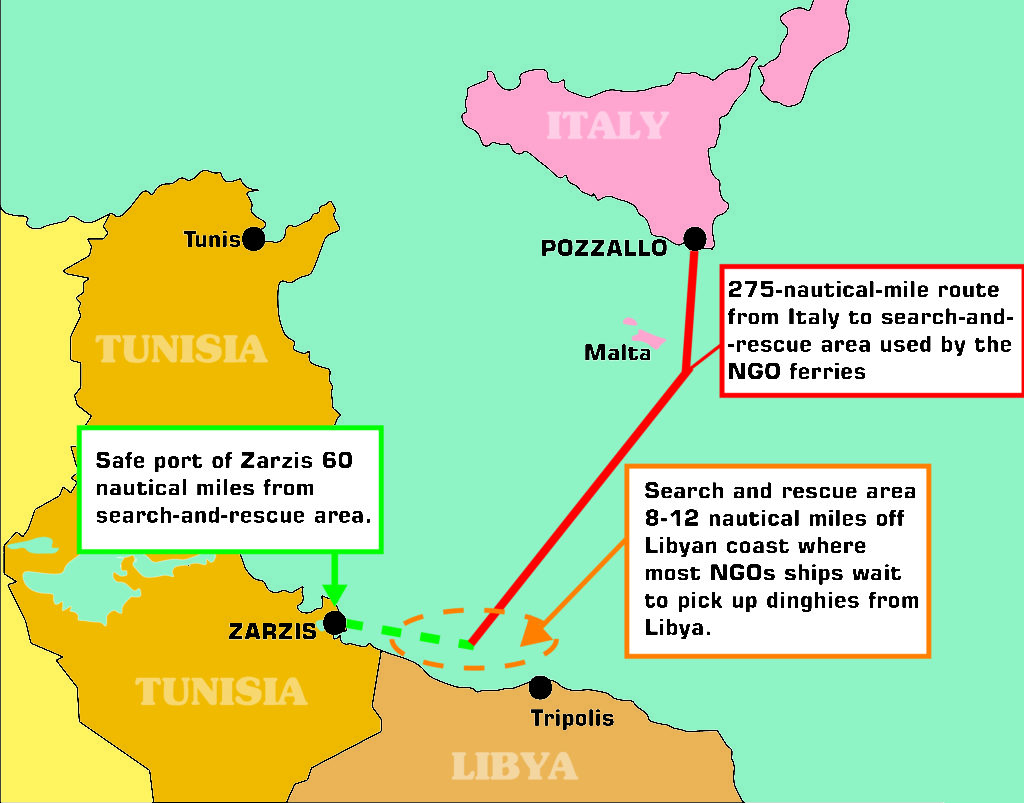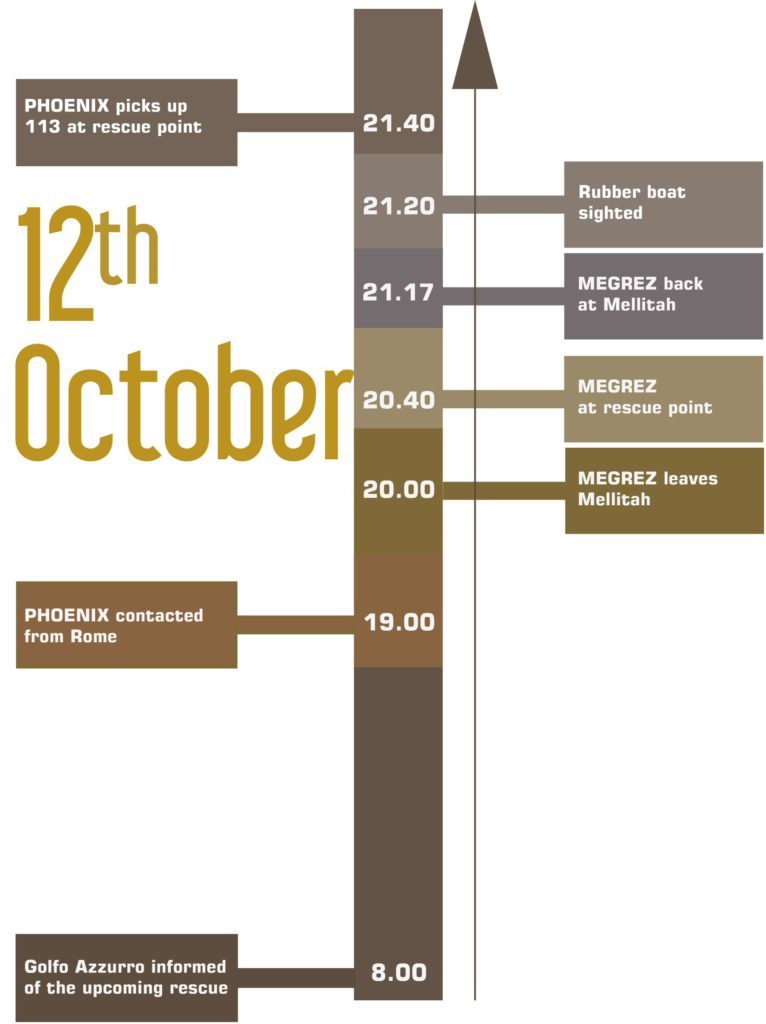Caught in the Act: NGOs Deal in Migrant Smuggling
IN FOCUS, 14 Nov 2016
Gefira – TRANSCEND Media Service
 10 Nov 2016 – Ship-tracking software and reports from journalists prove that NGOs, the Italian Coast Guard and smugglers coordinate their actions. The Automatic Identification System (AIS) exposes NGOs operating in Libyan territorial waters. Since the ouster of President Ghadafi, a growing number of Africans are smuggled into Europe.
10 Nov 2016 – Ship-tracking software and reports from journalists prove that NGOs, the Italian Coast Guard and smugglers coordinate their actions. The Automatic Identification System (AIS) exposes NGOs operating in Libyan territorial waters. Since the ouster of President Ghadafi, a growing number of Africans are smuggled into Europe.
They travel via Libya from where they cross the Mediterranean. Different “humanitarian” organisations or NGOs involved are an indispensable part of the smuggle route to Europe. We noticed that the Italian coast guard, NGOs and locals coordinate their actions. Whatever they call it themselves, these operations cannot be classified as genuine rescue operations.
The Dutch, Maltese and German based NGOs are part of the human smuggling network and one wonders, are these NGOs themselves criminal organisations.
Whatever the motives of these NGOs, their behaviour is illegal, and in countries governed by a constitution, i.e. European states, crime should be prosecuted regardless of the intention of its perpetrators.
We followed the movements of the Golfo Azzurro on 12 October. We used AIS Marine Traffic signals, twitter and the live reports of a Dutch journalist on board of the Golfo Azzurro.
On the evening of 12 October at 21:15, 113 people were picked up 8.5 nautical miles off the Libyan Mellitah Complex, by four NGO ships; the Phoenix, the Astral, the Iuventa and the Golfo Azzurro. At that moment these four ships were within the territorial waters of Libya.
During this transport, 17 persons were reported missing, including a three-year-old child.
Wednesday 12 October eight o’clock in the morning, the Italian coast guard informed the Golfo Azzurro about the coming “rescue” operation, 10 to 12 hours in advance; they directed the Golfo Azzurro to a location within the Libyan territorial waters. Eveline Rethmeier, a Dutch journalist, was on board of the Golfo Azzurro. At 20:23 (UTC time 18:23) she posted a video were ‘Chief of the Mission’ Mateo told the crew something was coming. In her blog she wrote: “At eight o’clock in the morning we got the messages that there is a ship with problems 30 nautical miles away from us. The Italian coast guard asked assistance in the area. We were briefed by ‘Chief of the Mission’ Mateo. He told us that we should be prepared for guests.”1)
The Italian coast guard did not only direct the Golfo Azzurro to the Libyan territorial waters but also the Phoenix, the Astral and the Iuventa. According to the Malta Today: “It was around 7 pm (12 October) when the Maritime Rescue Coordination Centre in Rome contacted Phoenix. Still, it was only at 9.20pm that the rubber boat was sighted by – making use of the Schiebel drones on board the Phoenix. In cooperation with the other search-and-rescue NGOs in the area, a rescue operation was swiftly launched.”2) The Golfo Azzurro was told at 8.00 AM that there was a ship with problems while the Phoenix was contacted 10 to 11 hours later!
During the week that we monitored the area, four Italian tugboats, among them the Megrez, were stationed at the Mellitah Complex, and they were idle most of the time.
While the Golfo Azzurro started its 30-mile trip to assist the boat 6 to 9 nautical miles off Mellitah, it took 10 hours before the Megrez, one of the four tug boats, left the port of Mellitah (20:00 pm) in the direction of the “rescue” point.
The Megrez sailed 6 nautical miles into the open sea, 2 nautical miles from the rescue point. Around 20:40 it reached its end point and without stopping it turned around and went back to Mellitah, where it arrived at 21:17. The whole trip including time, date and speed is recorded by the different AIS tracking websites.
The Megrez, an Italian registered tugboat, sailed in a straight line up and down without stopping and without participating in the “rescue” operation. It looks like the Megrez just dropped something in the open sea and immediately returned home. Forty minutes later after the Megrez turned around, perfectly timed, the Phoenix spotted a boat with migrants.
8.5 nautical miles off Mellitah, within Libyan territorial waters, the four ships, belonging to European NGOs, started their “rescue” mission and picked up 113 persons. The closest safe port is Zarzis in Tunis, about 65 nautical miles west from the “rescue” point. This port is frequently visited by the ships that operate for these NGOs. Instead of bringing the migrants to Zarzis, the Phoenix brought the immigrants 275 nautical miles north to Italy. Of course, the 113 passengers paid 1000 to 1500 euro to be shipped to Europe and not to be transported to Tunis.
On the basis of our observation, it turned out that the Italian authorities knew in advance that there would be a “rescue” operation that night.
They contacted the Golfo Azzurro in advance as the ship was more than 30 nautical miles off the Libyan coast. The captain knew that he was scheduled to pick up migrants, although there was not yet a distress signal. At that moment the migrants were probably still in Libya. At 19:00 the Phoenix was warned by the coast guard and directed to the pick-up point. At 20:00 the Megrez left Libya. 2 nautical miles from the pick-up point, at 20:40 hours it turned around. Forty minutes later the Phoenix spotted the rubber boat. The whole operation was perfectly scheduled. 3)
It looks like the “rescue” is a part of a well organised hazardous human trafficking operation. The fact that 17 people went missing does not make this a rescue mission. The organisers and those involved are entirely responsible for the safety of their passengers and should be held accountable.
httpv://www.youtube.com/watch?v=eDBNyEplPOk
REFERENCES:
| 1. | ↑ | Live: zoeken naar vluchtelingenbootjes, zo gaat dat, RTL. |
| 2. | ↑ | Boy, 3, among missing migrants believed to have drowned in the Mediterranean Sea, Malta Today. |
| 3. | ↑ | Boat sinking in Strait of Sicily, 3-year-old missing, ANSA. |
_________________________________________
Gefira – Global Analysis from the European Perspective. Preparing for the world of tomorrow.
DISCLAIMER: The statements, views and opinions expressed in pieces republished here are solely those of the authors and do not necessarily represent those of TMS. In accordance with title 17 U.S.C. section 107, this material is distributed without profit to those who have expressed a prior interest in receiving the included information for research and educational purposes. TMS has no affiliation whatsoever with the originator of this article nor is TMS endorsed or sponsored by the originator. “GO TO ORIGINAL” links are provided as a convenience to our readers and allow for verification of authenticity. However, as originating pages are often updated by their originating host sites, the versions posted may not match the versions our readers view when clicking the “GO TO ORIGINAL” links. This site contains copyrighted material the use of which has not always been specifically authorized by the copyright owner. We are making such material available in our efforts to advance understanding of environmental, political, human rights, economic, democracy, scientific, and social justice issues, etc. We believe this constitutes a ‘fair use’ of any such copyrighted material as provided for in section 107 of the US Copyright Law. In accordance with Title 17 U.S.C. Section 107, the material on this site is distributed without profit to those who have expressed a prior interest in receiving the included information for research and educational purposes. For more information go to: http://www.law.cornell.edu/uscode/17/107.shtml. If you wish to use copyrighted material from this site for purposes of your own that go beyond ‘fair use’, you must obtain permission from the copyright owner.



The article above makes assumptions of motive without any mention of what drives the participants. Of course the rescue services are going to try to find out where the boats are as soon as they can. They are there to save lives not promote an uncharitable ideology as the writer does.
That begs the question. Who is the anonymous writer who seems to have no conception of why so many people risk their lives to get out of Libya?
Nor do they understand Italy’s motives. They joined the attack on Libya to get out of paying the compensation they agreed to in reparation for their colonial atrocities. Part of the treaty included Gaddafi’s Libya policing the people smugglers. Thankfully their conscience finally kicked in.